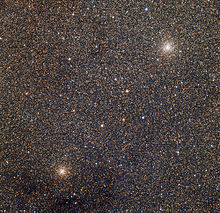NGC 6528 is a globular cluster in the constellation Sagittarius, and is listed in the New General Catalogue. It has an apparent magnitude of about 11 and a diameter of about 16 arcminutes, and its Shapley-Sawyer Concentration Class is V, containing stars of 16th magnitude and dimmer.[2] Dreyer described it as "pF, cS, R", meaning poor and faint, considerably small and round.
| NGC 6528 | |
|---|---|
 The globular cluster NGC 6528, imaged by the Hubble Space Telescope | |
| Observation data (J2000 epoch) | |
| Class | V |
| Constellation | Sagittarius |
| Right ascension | 18h 04m 49.61s[1] |
| Declination | −30° 03′ 20.8″[1] |
| Distance | 25.8 kly (7.9 kpc)[1] |
| Apparent magnitude (V) | 10.65[1] |
| Physical characteristics | |
| Radius | 8.3' x 8.3'[2] |
| Metallicity | = -0.11[3] dex |
| Other designations | GCl 84, ESO 456-48, VDBH 257[1] |
NGC 6528 is located southwest of NGC 6522, another globular cluster. Both are located in Baade's Window, a relatively clear area near the galactic equator.
The globular cluster was discovered in 1784 by the astronomer William Herschel with his 18-inch telescopes.
The NGC 6528 is unusually metal-rich for a globular cluster, and is very similar in composition to NGC 6553, suggesting an origin in a similar environment.[4]

References
edit- ^ a b c d e "NGC 6528". SIMBAD. Centre de données astronomiques de Strasbourg. Retrieved 8 January 2017.
- ^ a b "NGC 6528". Retrieved 8 January 2016.
- ^ "A Galactic Globular Clusters Database: NGC 6528". Retrieved 8 January 2017.
- ^ Muñoz, C.; Geisler, D.; Villanova, S.; Saviane, I.; Cortés, C. C.; Dias, B.; Cohen, R. E.; Mauro, F.; Moni Bidin, C. (2018), "Chemical analysis of NGC 6528: One of the most metal-rich bulge globular clusters", Astronomy & Astrophysics, 620: A96, arXiv:1809.04164, doi:10.1051/0004-6361/201833373, S2CID 119085692
- Robert Burnham, Jr, Burnham's Celestial Handbook: An observer's guide to the universe beyond the solar system, vol 3, p. 1555
- NGC 6528 @ SEDS
External links
edit- Media related to NGC 6528 at Wikimedia Commons
![{\displaystyle {\begin{smallmatrix}\left[{\ce {Fe}}/{\ce {H}}\right]\end{smallmatrix}}}](https://wikimedia.org/api/rest_v1/media/math/render/svg/4c0821bd80891e071c08e7c7ee8e022baedf522c)